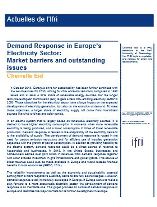Demand Response in Europe’s Electricity Sector: Market barriers and outstanding issues

In October 2014, Europe’s drive for sustainability has been further continued with the set objectives for 2030, aiming for 40% emission reduction compared to 1990 levels and at least a 27% share of renewable energy sources. For the longer term, the European Commission (EC) targets a zero CO2 emitting electricity sector in 2050. Those objectives for the electricity sector have a large impact on the expected development of electricity generation, but also on the evolution of demand. To meet those objectives, a larger share of electricity supply will come from intermittent sources like wind turbines and solar panels.
In an electric system that is largely based on renewable electricity sources, it is desired to have higher electricity consumption in moments when more renewable electricity is being produced, and a lower consumption in times of lower renewable production. Demand response is related to the adaptability of the electricity demand to the availability of supply. The development of demand response is rooted in the need for carbon emission reductions and for efficient use of installed generation capacities with the growth of power consumption. In addition to providing flexibility to the electric system, demand response could be a direct source of revenue to households and businesses. In 2013, in the United States, businesses and homeowners earned over $2.2 billion in revenues from demand response together with other avoided investment in grid infrastructure and power plants. This source of direct revenue could also be made available in Europe and would release financial benefits to local economies (SEDC, 2014).
The reliability improvements as well as the economic and sustainability potential coming from a more responsive electricity demand are fully acknowledged. However, demand response is still immaturely developed in Europe. If Europe wants to make a step forward to a more sustainable electricity sector, the development of demand response is an inevitable one. This paper provides an outline of demand response in Europe and identifies the major barriers for its further development in Europe.
Download the PDF to read further:

Available in:
Regions and themes
ISBN / ISSN
Share
Download the full analysis
This page contains only a summary of our work. If you would like to have access to all the information from our research on the subject, you can download the full version in PDF format.
Demand Response in Europe’s Electricity Sector: Market barriers and outstanding issues
Related centers and programs
Discover our other research centers and programsFind out more
Discover all our analysesAI, Data Centers and Energy Demand: Reassessing and Exploring the Trends
The information and communication technologies sector today accounts for 9% of global electricity consumption, data centers for 1-1.3%, and artificial intelligence (AI) for less than 0.2%. The growing energy demands of cloud services first, and now AI workloads (10% of today’s data centers electricity demand), have exacerbated this trend. In the future, hyperscale data centers will gain shares amongst all kinds of data centers and AI will probably account for around 20% of data centers electricity demand by 2030.
Unlocking India’s Energy Transition: Addressing Grid Flexibility Challenges and Solutions
India is rapidly scaling up its renewable energy (RE) capacity, adding 15–20 GW annually, but the ambitious goal of 500 GW of non-fossil capacity by 2030 is at risk unless the pace accelerates.
Europe’s Black Mass Evasion: From Black Box to Strategic Recycling
EV batteries recycling is a building block for boosting the European Union (EU)’s strategic autonomy in the field of critical raw minerals (CRM) value chains. Yet, recent evolutions in the European EV value chain, marked by cancellations or postponements of projects, are raising the alarm on the prospects of the battery recycling industry in Europe.

The New Geopolitics of Energy
Following the dramatic floods in Valencia, and as COP29 opens in Baku, climate change is forcing us to closely reexamine the pace—and the stumbling blocks—of the energy transition.









